21.1: Radiative Balance
- Page ID
- 10189
Consider an Earth with no atmosphere (Fig. 21.1). Given the near-constant climate described above, assume a balance of radiation input and output.
Incoming solar radiation minus the portion reflected, multiplied by the area intercepted by Earth, gives the total radiative input:
\begin{align}\text {Radiation } \operatorname{In}=(1-A) \cdot S_{o} \cdot \pi \cdot R_{\text {Earth}}^{2}\tag{21.1}\end{align}
where the fraction reflected (A = 0.294) is called the global albedo (see INFO Box). The annual-average total solar irradiance (TSI) over all wavelengths as measured by satellites is So = 1361 W·m–2. The interception area is the same as the area of Earth’s shadow — a disk of area πREarth2, where REarth = 6371 km is the average radius of Earth. The TSI has fluctuated about ±0.5 W·m–2 (the thickness of the vertical dashed line in Fig. 21.2) during the past 33 years due to the average sunspot cycle. See the Solar & IR Radiation chapter for TSI details.
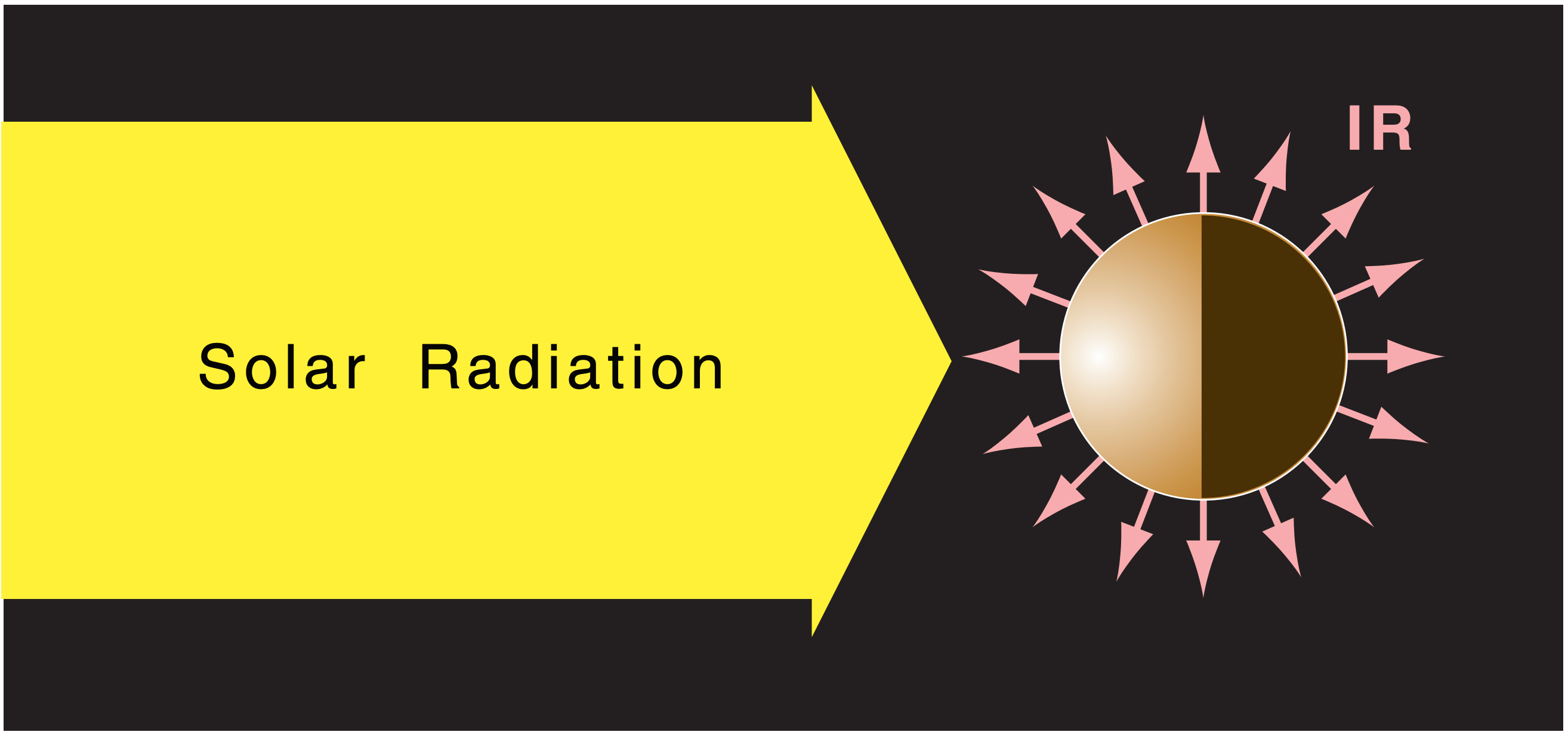
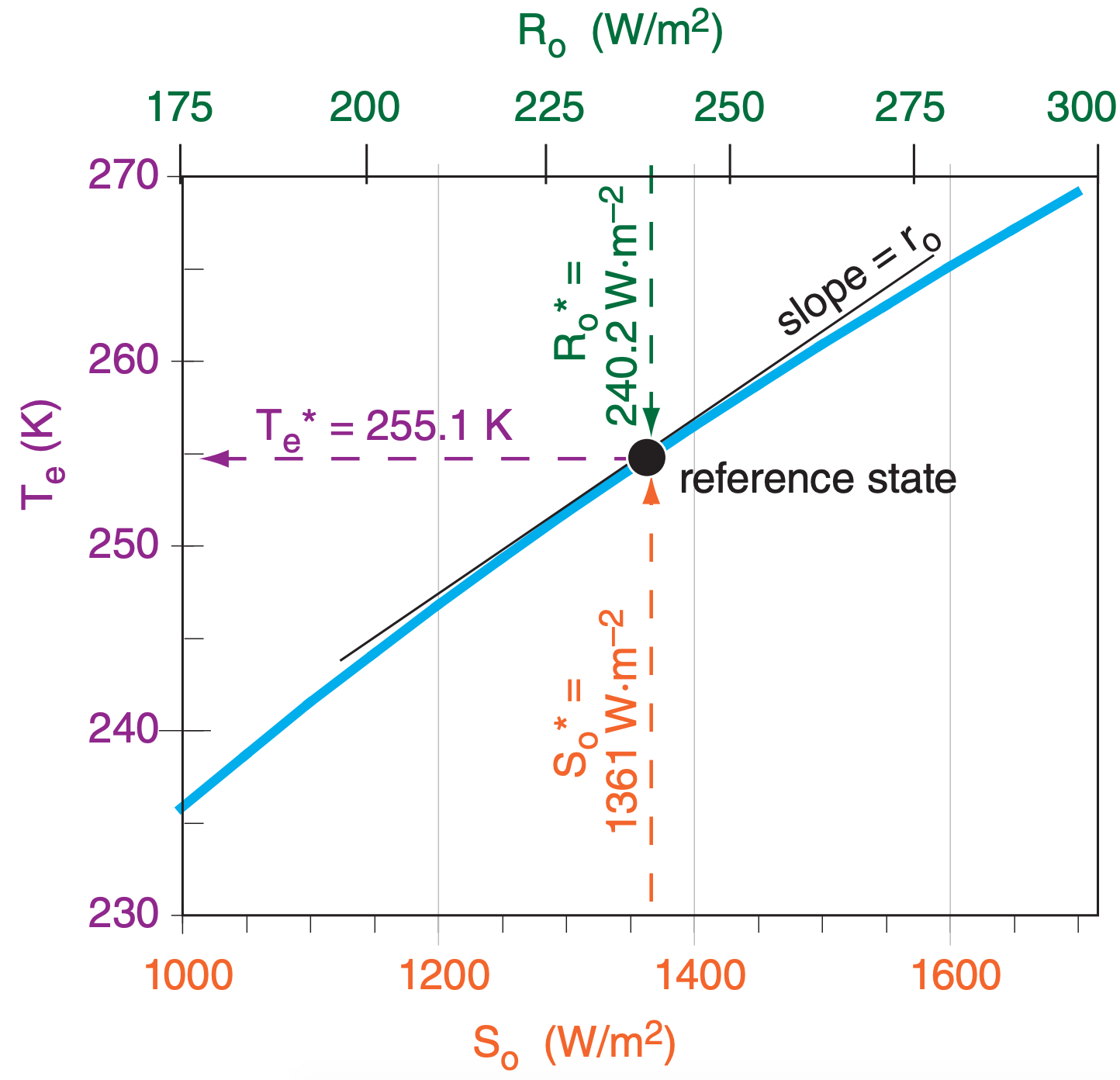
IR radiation is emitted from every point on Earth’s surface, which we will assume to behave as a radiative blackbody (emissivity = 1). For this toy model, assume that the earth is spherical with surface area 4·πREarth2. If IR emissions/area are given by the Stefan-Boltzmann law (eq. 2.15), then the total outgoing radiation is:
\begin{align}\text {Radiation Out }=4 \pi \cdot R_{\text {Earth}}^{2} \cdot \sigma_{S B} \cdot T_{e}^{4}\tag{21.2}\end{align}
where the Stefan-Boltzmann constant is σSB = 5.67x10–8 W·m–2·K–4.
The real Earth has a heterogeneous surface with cold polar ice caps, warm tropical continents, and other temperatures associated with different terrestrial and aquatic geographic features. Define an effective radiation emission temperature (Te) such that the emissions from a hypothetical earth of uniform surface temperature Te is the same as the total heterogeneous-Earth emissions.
For a steady-state climate (i.e., no temperature change with time), outputs must balance the inputs. Thus, equate outgoing and incoming radiation from eqs. (21.1 and 21.2), and then solve the resulting equation for Te :
\begin{align}
T_{e} &=\left[\frac{(1-A) \cdot S_{o}}{4 \cdot \sigma_{S B}}\right]^{1 / 4}=\left[\frac{R_{o}}{\sigma_{S B}}\right]^{1 / 4}
\approx 255.1 \mathrm{K} \approx-18.0^{\circ} \mathrm{C}\tag{21.3}\end{align}
where Ro = (1–A)·So/4.
Fig. 21.2 shows this reference state at 255.1K, given an albedo of 0.294. It also shows how changes of solar irradiance along the abscissa of the graph need only small changes in effective temperature along the ordinate in order to reach a new radiative equilibrium. Namely, the radiation balance describes a negative feedback that causes a stable climate rather than runaway global warming.
Sample Application
Show the calculations leading to Te = –18.0°C.
Given: Te = –18.0°C, So = 1361 W·m–2 , A = 0.294
Find: Show the calculation
Use eq. (21.3):
\(\ T_{e} =\left[\frac{(1-0.294) \cdot\left(1361 \mathrm{W} \cdot \mathrm{m}^{-2}\right)}{4 \cdot\left(5.67 \times 10^{-8} \mathrm{W} \cdot \mathrm{m}^{-2} \cdot \mathrm{K}^{-4}\right)}\right]^{1 / 4}
=255.1 \mathrm{K}=\bf{-18.0^{\circ} \mathrm{C}}\)
Check: Physics & units are OK.
Exposition: Earth’s radius appears in both the radiation-in and -out equations, but is not in eq. (21.3).
The geological record illustrates the steadiness of Earth’s past climate (Fig. 21.3). About 60 M years ago, the absolute temperature of Earth’s surface averaged roughly 5% warmer (i.e., 14 K = 14°C warmer ) than present. For the most recent 10 k years, the geologic record indicates temperature oscillations on the order of ±1°C relative to our current average surface temperature of 15°C. Nonetheless, these small temperature changes (with ∆T range of 20°C over the past 500 Myr) can cause significant changes in ice-cap coverage and sea level.
But our simple toy model is perhaps too simple, because the modeled –18.0°C temperature is colder than the +15°C actual surface temperature (from Chapter 1). To improve the modeled temperature, we must include some additional physics.

21.1.1. The So-called “Greenhouse Effect”
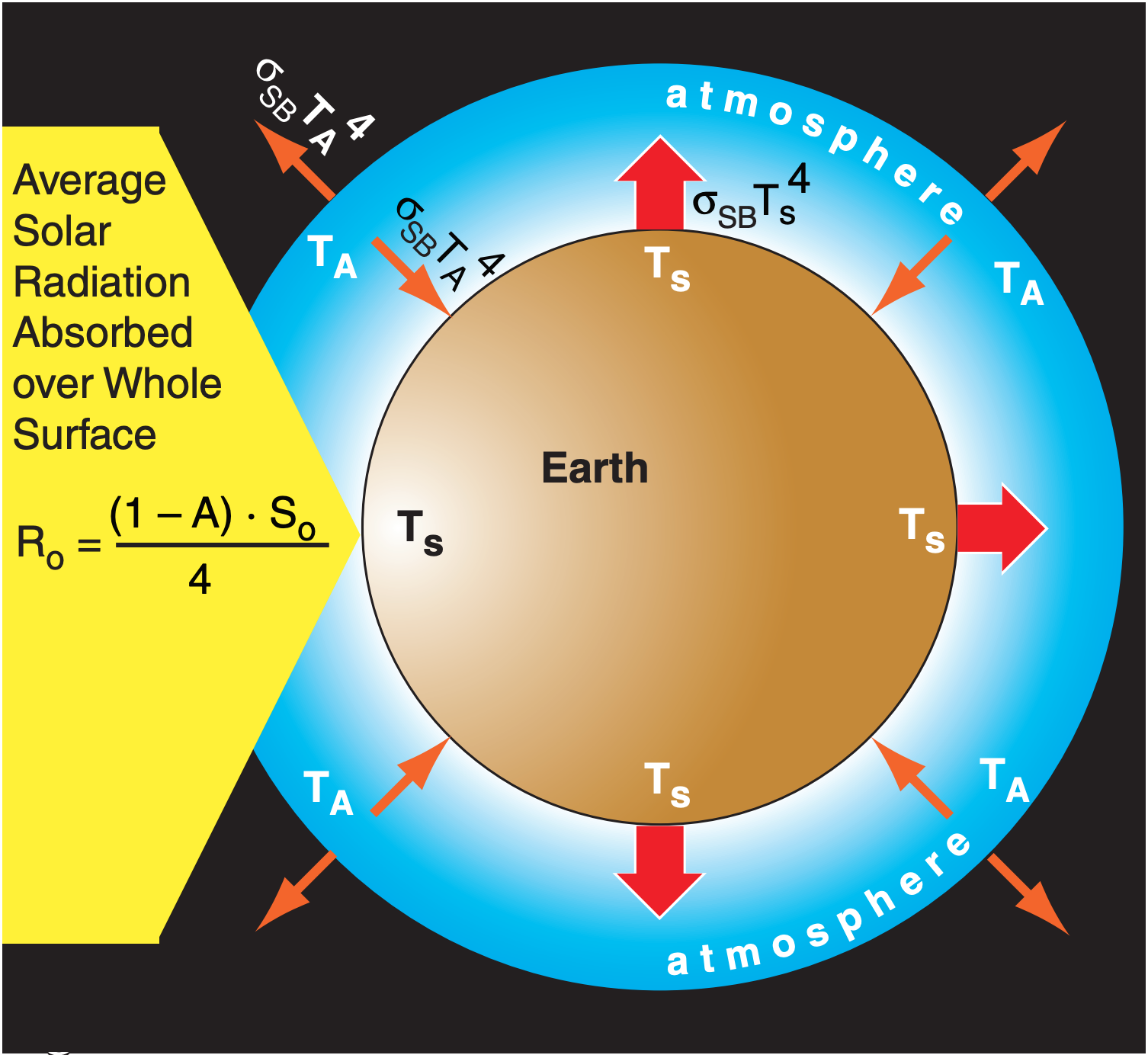
To make our Earth-system model slightly more realistic, add an atmosphere of uniform absolute temperature TA everywhere (Fig 21.4). Suppose this atmosphere is opaque (not transparent) in the IR, but is perfectly transparent for visible light.
For this idealized case, sunlight shines through the atmosphere and reaches the Earth’s surface, where a portion is reflected and a portion is absorbed, causing the surface to warm. IR emitted from the warm Earth is totally absorbed by the atmosphere, causing the atmosphere to warm. But the atmosphere also emits radiation: some upward to space, and some back down to the Earth’s surface (a surface that absorbs 100% of the IR that hits it).
This downward IR from the atmosphere adds to the solar input, thus allowing the Earth’s surface to have a greater surface temperature Ts than with no atmosphere. This is called the greenhouse effect, even though real greenhouses do not work this way. Water vapor is one of many “greenhouse gases” that absorbs and emits IR radiation.
Assume the atmosphere-Earth system has existed for sufficient years to reach a steady state. Such an equilibrium state requires outgoing IR from the atmosphere-Earth system to balance absorbed incoming solar radiation. Namely:
\begin{align}T_{A}=T_{e}=255.1 \mathrm{K}=-18.0^{\circ} \mathrm{C}\tag{21.4}\end{align}
Thus, the temperature of the atmosphere must equal the effective emission temperature for the atmosphere-Earth system.
In Figs. 21.4 and 21.5, the net solar input Ro is given as (1–A)·So/4 instead of So. The (1–A) factor is because any sunlight reflected back to space is not available to heat the Earth system. But why also divide by 4? The reason is due to geometry.
Of the radiation streaming outward from the sun, the shadow cast by the Earth indicates how much radiation was intercepted. The shadow is a circle with radius equal to the Earth’s radius REarth, hence the interception area is π·REarth2.
But we prefer to study the energy fluxes relative to each square meter of the Earth’s surface. The surface area of a sphere is 4·π·REarth2. Namely, the surface area is four times the area intercepted by the sun.
Hence, the average net solar input that we allocate to each square meter of the Earth’s surface is: Ro = (1–A)·So/4 = (1–0.294)·(1361 W·m–2)/4 = 240.2 W·m–2.
You can use the Stefan-Boltzmann law σSB·TA4 to find the radiation emitted both up and down from the atmosphere, which is assumed to be thin relative to Earth’s radius. For the atmosphere to be in steady-state, these two streams of outgoing IR radiation must balance the one stream of incoming IR from the Earth’s surface σSB·Ts4, which requires:
\begin{align}\sigma_{S B} \cdot T_{s}^{4}=2 \cdot \sigma_{S B} \cdot T_{e}^{4}\tag{21.5}\end{align}
Thus
\begin{align}
T_{s} &=2^{1 / 4} \cdot T_{e}
=303.4 \mathrm{K}=30.2^{\circ} \mathrm{C}\tag{21.6}\end{align}
While the no-atmosphere case was too cold, this opaque-atmosphere case is too warm (recall from Chapter 1 that the standard atmosphere Ts = 15°C). Perhaps the air is not fully opaque in the IR.
Sample Application
What temperature is the Earth’s surface for the one-layer atmosphere of the previous sample applic.
Find the Answer
Given: Te = 255.1 K
Find: Ts = ? K
Apply eq. (21.6): Ts = 21/4·(255.1K) = 303.4 K = 30.2C
Check: Physics and units are OK.
Exposition: Twice the radiation at Earth’s surface, but not twice the surface absolute temperature.
21.1.2. Atmospheric Window
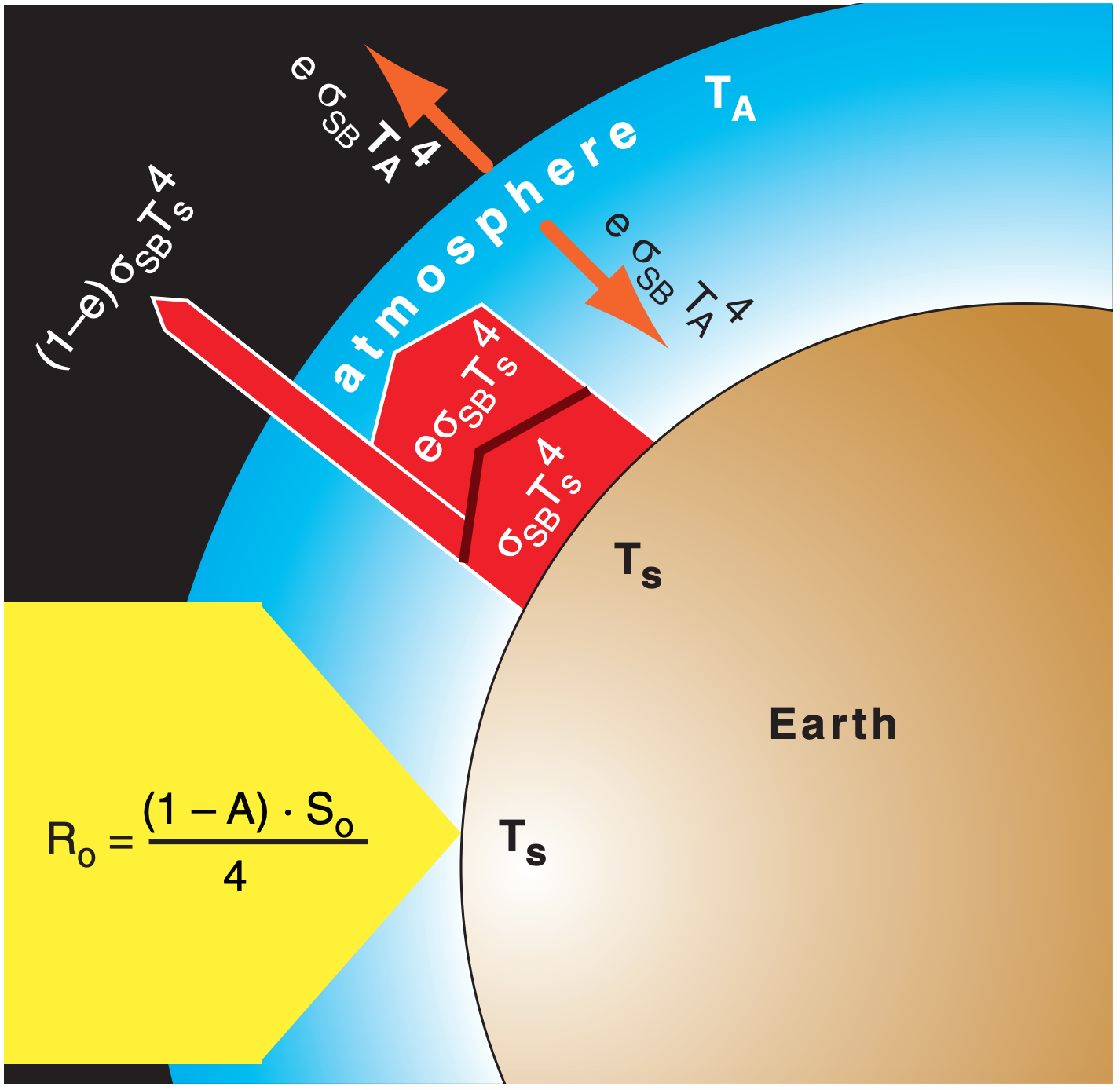
As discussed in the Satellites & Radar chapter, Earth’s atmosphere is partially transparent (i.e., is a dirty atmospheric window) for the 8 to 14 µm range of infrared radiation (IR) wavelengths and is mostly opaque at other wavelengths. Of all the IR emissions upward from Earth’s surface, suppose that 89.9% is absorbed and 10.1% escapes to space (Fig. 21.5). Thus, the atmosphere will not warm as much, and in turn, will not re-emit as much radiation back to the Earth’s surface.
At each layer (Earth’s surface, atmosphere, space) outgoing and incoming radiative fluxes balance for an Earth-system in equilibrium. Also, fluxes out of one layer are input to an adjacent layer. For example, the radiative balance of the atmosphere becomes
\begin{align}e_{\lambda} \cdot \sigma_{S B} \cdot T_{s}^{4}=2 \cdot e_{\lambda} \cdot \sigma_{S B} \cdot T_{A}^{4}\tag{21.7}\end{align}
while at the Earth’s surface it is
\begin{align}R_{o}+e_{\lambda} \cdot \sigma_{S B} \cdot T_{A}^{4}=\sigma_{S B} \cdot T_{s}^{4}\tag{21.8}\end{align}
From Kirchhoff’s law (see the Solar & IR Radiation chapter), recall that absorptivity equals emissivity, which for this idealized case is eλ = aλ = 89.9%. Eqs. (21.3, 21.7 & 21.8) can be combined to solve for key absolute temperatures:
\begin{align}T_{A}^{4}=\frac{T_{e}^{4}}{2-e_{\lambda}}\tag{21.9}\end{align}
\begin{align}T_{s}^{4}=\frac{2 \cdot T_{e}^{4}}{2-e_{\lambda}}\tag{21.10}\end{align}
where Te is still given by eq. (21.4). The result is:
\(\ T_{A} \approx 249.1 \mathrm{K}=-24.1^{\circ} \mathrm{C}\)
and
\begin{align}T_{s} \approx 296.2 \mathrm{K}=23.0^{\circ} \mathrm{C}\tag{21.11}\end{align}
The temperature at Earth’s surface is more realistic, but is still slightly too warm.
A by-product of human industry and agriculture is the emission of gases such as methane (CH4), carbon dioxide (CO2), freon CFC-12 (C Cl2 F2), and nitrous oxide (N2O) into the atmosphere. These gases, known as anthropogenic greenhouse gases, can absorb and re-emit IR radiation that would otherwise have been lost out the dirty window. The resulting increase of IR emissions from the atmosphere to Earth’s surface could cause global warming.
21.1.3. Average Energy Budget
Radiation is not the only physical process that transfers energy. Between the Earth and the bottom layer of the atmosphere there can be sensible-heat transfer via conduction (see the Thermodynamics chapter) and latent-heat transfer via evapotranspiration (see the Water Vapor chapter). Once this heat and moisture are in the air, they can be transported further into the atmosphere by the mean wind, by deep convection such as thunderstorms, by shallow convection such as thermals, and by smaller turbulent eddies in the atmospheric boundary layer.
One estimate of the annual mean of energy fluxes between all these components, when averaged over the surface area of the globe, is sketched in Fig. 21.6. According to the Stefan-Boltzmann law, the emitted IR radiation from the Earth’s surface (398 W·m–2) corresponds to an blackbody surface temperature of 16.3°C, which is close to the observed value of 15°C.
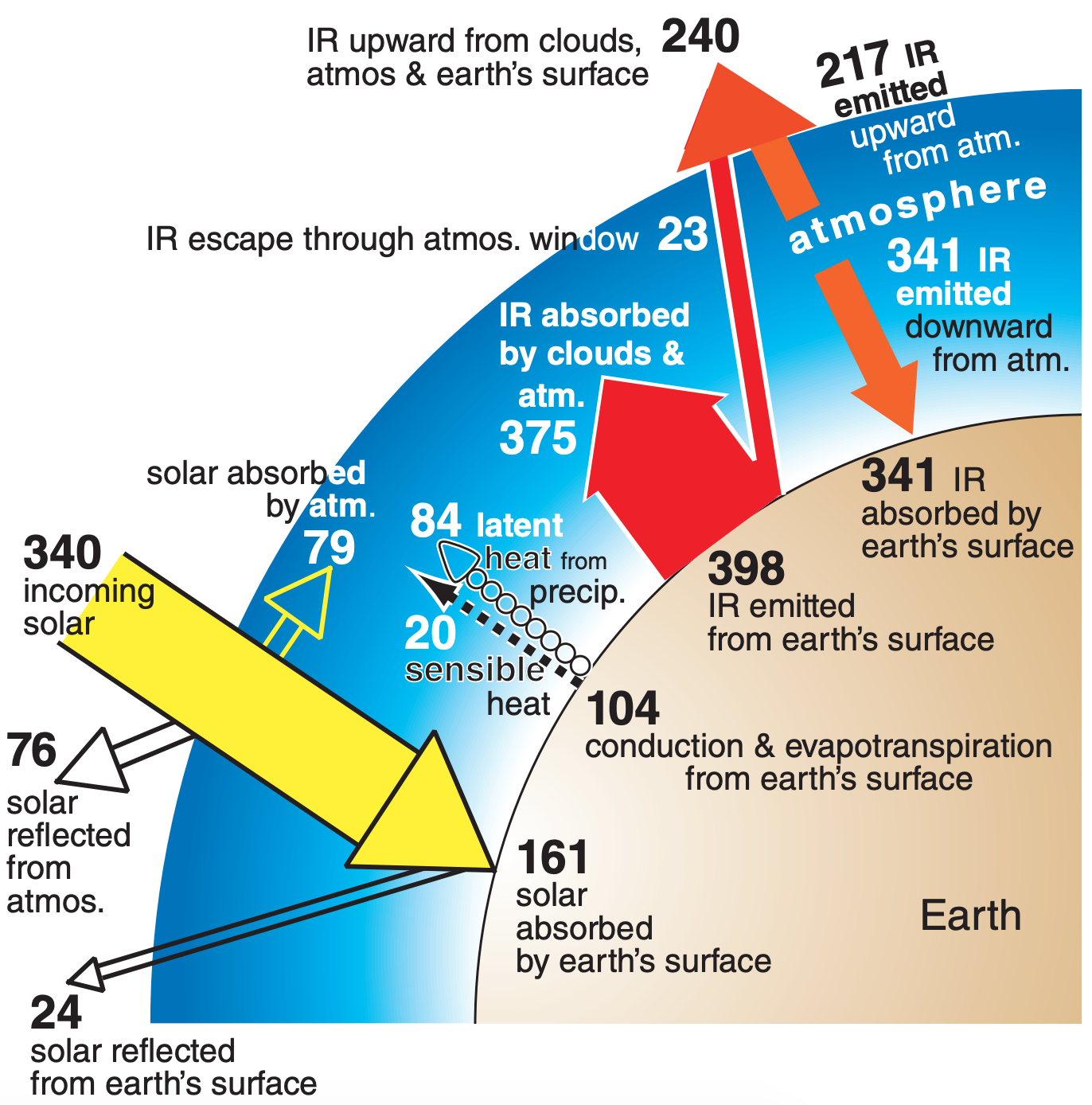
Sample Application
Confirm that energy flows in Fig. 21.6 are balanced.
Find the Answer
Solar: incoming = [reflected] + (absorbed)
340 = [76 + 24] + (79 + 161)
340 = 340 W·m–2
Earth’s surface: incoming = outgoing
(161 + 341) = (104 + 398)
502 = 502 W·m–2
Atmosphere: incoming = outgoing
(79 + 20 + 84 + 375) = (217 + 341)
Earth System: in from space = out to space
340 = (24 + 76 + 23 + 217)
Check: Yes, all budgets are balanced.
Exposition: The solar budget must balance because the Earth-atmosphere system does not create/emit solar radiation. However, IR radiation is created by the sun, Earth, and atmosphere; hence, the IR fluxes by themselves need not balance.


